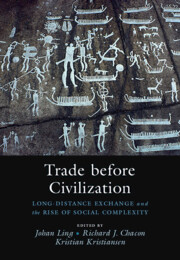Book contents
- Trade before Civilization
- Trade before Civilization
- Copyright page
- Contents
- Contributors
- Chapter One New Perspectives on Long-Distance Trade and Social Complexity
- Part I Exchange and Social Evolution: Forms of Trade in Egalitarian, Transegalitarian, and Chiefdom Societies
- Part II The Role That Specific Institutions And Agents Played in Long-Distance Exchange
- Part III The Role of Political Economy and Elite Control in Long-Distance Exchange
- Part IV Marxian And Post-Colonial Approaches as well as World System Theory in Relation to Gift Exchange and MacroRegional Exchange
- Part V Commentary on Contributions to This Volume
- Index
- References
Chapter One - New Perspectives on Long-Distance Trade and Social Complexity
Published online by Cambridge University Press: 25 August 2022
- Trade before Civilization
- Trade before Civilization
- Copyright page
- Contents
- Contributors
- Chapter One New Perspectives on Long-Distance Trade and Social Complexity
- Part I Exchange and Social Evolution: Forms of Trade in Egalitarian, Transegalitarian, and Chiefdom Societies
- Part II The Role That Specific Institutions And Agents Played in Long-Distance Exchange
- Part III The Role of Political Economy and Elite Control in Long-Distance Exchange
- Part IV Marxian And Post-Colonial Approaches as well as World System Theory in Relation to Gift Exchange and MacroRegional Exchange
- Part V Commentary on Contributions to This Volume
- Index
- References
Summary
How an ancient object, artefact or commodity has moved over vast distances from one region to another, crossed major seas or travelled by land over extensive territories, has occupied and intrigued scholars in many disciplines over the years (Sabloff and Lamberg-Karlovsky 1975; Kristiansen et al. 2018). This subject becomes even more intriguing knowing that no textual evidence can give us a hint or a glimpse how this was organized. Since the beginning of modern humans in the Palaeolithic, migration and mobility have driven demographic expansion and the movement of material culture. At the same time, social interaction and intermarriage between groups constituted a basic institutional pattern among modern humans to prevent inbreeding, as demonstrated by ancient DNA (Sikora et al. 2017). New genetic evidence provides insights into patterns of human mobility and genetic admixture. However, the onset of trade and exchange as an institutionalized activity is still not well understood. The challenge increases once we move back in time before any written sources can inform us. How did pre-modern/pre-state societies organize themselves to engage in long-distance exchange? How did such societies communicate? How did such societies foster conditions and/or social institutions that facilitated long-distance exchange? Can the rise of social complexity be connected to long-distance exchange? Exactly how far did traders, raiders and visitors travel in prehistory and how were there distant exchanges organized? All of these questions can be boiled down to two basic questions: when and under what circumstances did trade become institutionalized in pre-state societies, and what forms did such institutionalization take?
- Type
- Chapter
- Information
- Trade before CivilizationLong Distance Exchange and the Rise of Social Complexity, pp. 1 - 20Publisher: Cambridge University PressPrint publication year: 2022



